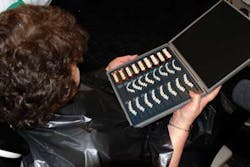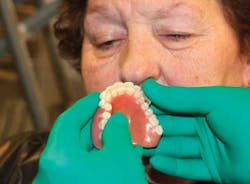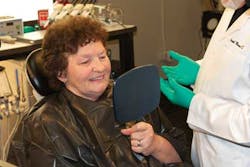A Simple Solution to One of the Oldest Dreaded Problems Confronting Dentists
By Joseph J. Massad, DDS
Welcome back! This month's tip addresses patients' expectations. This is one of the oldest universal problems with which dentists are confronted daily. This dreaded situation frequently places dentists in a no-win position and creates poor patient relations. This occurs despite the fact that most dentists claim their patients were fully informed and agreed on all aspects of treatment before they began the case.
Even with today's computer-aided esthetic design software programs, it has been my experience that patients want a preview in their own mouths. Choosing from a series of photographs or computer images may or may not allow patients to actually make informed decisions.
The more we can control this aspect of dentistry, the more successful our practices will be, and the less our blood pressures will rise.
The solution to this dilemma became obvious to me some years ago, and recently I tested my theory on a number of patients to determine the effectiveness of actually trying in a series of tooth prototypes in various shapes and sizes for my patients to view. In order to accomplish this, I used labial/buccal tooth shells (Visionaire Dental Shells*, Nobilium Division of CMP Industries LLC, Albany, N.Y.) that were very thin and all connected together. In addition, the shells were thermoplastic to bend and tilt in any configuration and could be manipulated over natural dentition, an existing denture, or set up in a wax rim to allow patients to preview. Below are a few examples of the use of one of the three sizes and one of the four molds offered.
Figure 1 – Patients are given various tooth molds and sizes to review and choose from. Each patient is asked to choose one, two, or even three molds and sizes so we can demonstrate how they would appear realistically in their mouth. Once the patient has chosen the tooth mold and size, simply take the tooth shells, place them in a controlled temperature water bath at 170 degrees for approximately fifteen seconds to make rubbery. If the patient has natural teeth, bend the one-piece connected shells around the labial/buccal of their teeth and then adjust the length, midline, anterior-posterior incline, and the height of the cervical dimension. Patients can instantly see how the particular mold and size appears in their own mouths.
The shells can be adhered to the patient's prosthesis or the natural teeth with the use of a white rope wax to hold them in place. With a mirror, patients view the actual shape, midline position, and length of the teeth. If the patient has too much gingiva showing, a larger set of shells can be exchanged to remedy this problem.
This esthetic preview is generally demonstrated at the exam appointment when we are discussing the treatment of the new prosthesis.
Figures 2 and 3 demonstrate how the shells are placed over an existing denture for the patient to view in the mouth. I have found this one step has practically eliminated complaints from the high-maintenance, esthetic-demanding type of patient.
Nothing is foolproof in dentistry. However, we need to understand that the authorship of esthetics is with the patient and not necessarily with the dental practitioner. It is true that some patients cannot make decisions or do not know exactly what they want until you complete their cases; however, this is less likely to occur when you allow or insist that your patients be the decision makers in their esthetic designs and tooth shades.
See you next month. I hope my pleasure in dentistry will also be yours.
Joe Massad
Dr. Joe Massad may be reached by phone at (918) 749-5600 or by e-mail at [email protected].
* Dr. Massad is designer of Visionaire Dental Shells
To see Dr. Massad's video tips, visit
www.DentalLibrary.com




